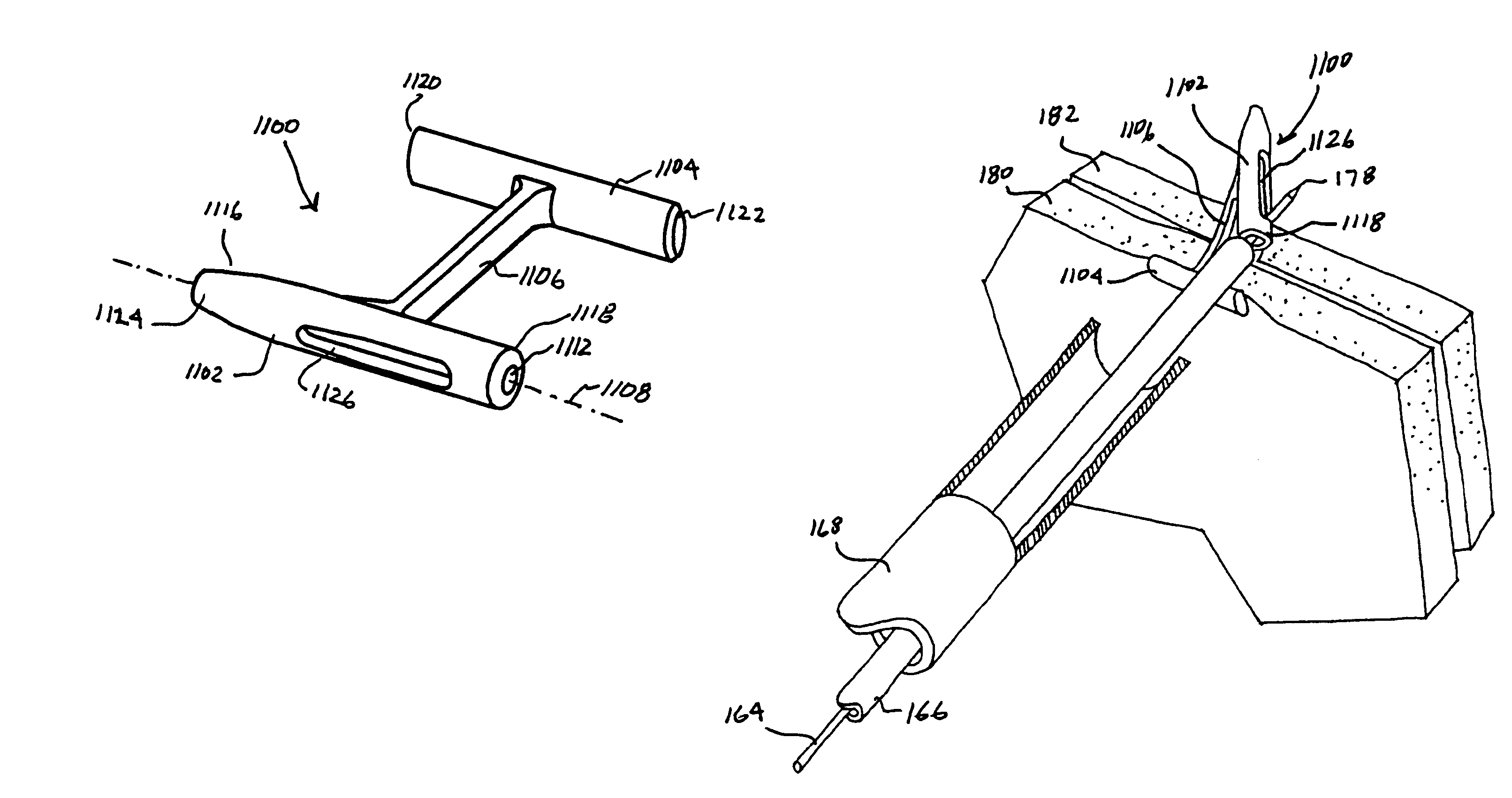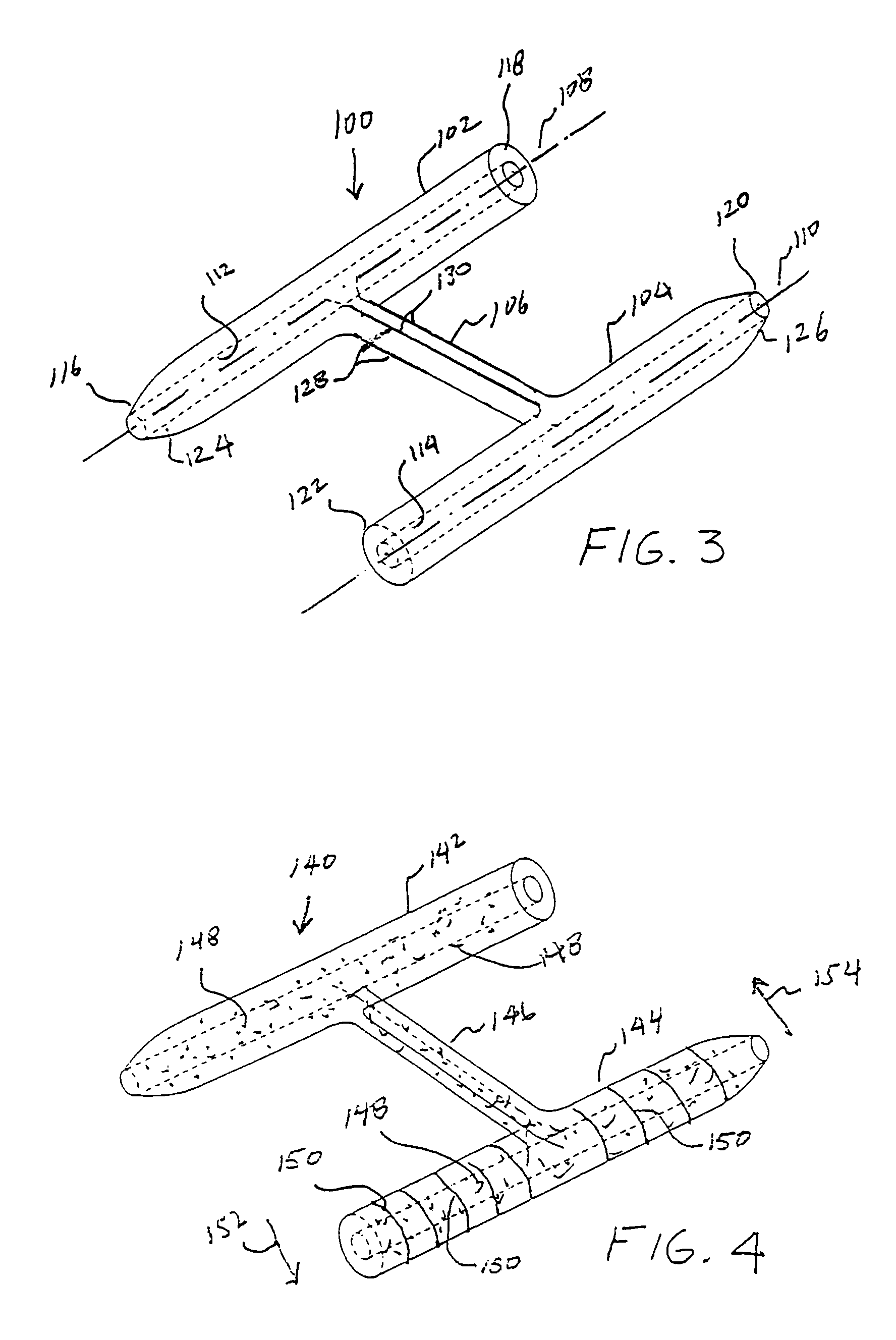Tissue fixation devices and assemblies for deploying the same
- Summary
- Abstract
- Description
- Claims
- Application Information
AI Technical Summary
Problems solved by technology
Method used
Image
Examples
embodiment 100
[0047]Referring now to FIG. 3, it is a perspective view of a fastener embodiment 100. The fastener 100 generally includes a first member 102, a second member 104, and a connecting member 106. As may be noted in FIG. 3, the first member 102 and second member 104 are substantially parallel and substantially perpendicular to the connecting member 106 which connects the first member 102 to the second member 104.
[0048]The first and second members 102 and 104 are generally cylindrical. Each has a longitudinal axis 108 and 110 and a through channel 112 and 114 along the longitudinal axes 108 and 110. The through channels 112 and 114 are formed by through bores which are dimensioned to be slidingly received on a tissue piercing deployment wire to be described hereinafter.
[0049]The first member 102 also includes a first end 116 and a second end 118. Similarly, the second member 114 includes a first end 120 and a second end 122. The first ends 116 and 120 form pointed dilation tips 124 and 12...
embodiment 140
[0051]Referring now to FIG. 4, it illustrates another fastener embodiment 140. As with the fastener 100 of FIG. 3, the fastener 140 includes a first member 142, a second member 144, and a connecting member 146. The fastener 140 may be formed in one piece and from plastic material similar to the fastener 100 of FIG. 3. The fasteners 100 and 140 may be formed of a plastic material which includes a color pigment, for example pthalocyanine blue, for contrasting with the color of body tissue to enable visualization of the fastener with an endoscope during the deployment of the fasteners. In addition, as may be seen in FIG. 4, the fastener 140 is impregnated with radio opaque material 148 so as to render the fastener 140 at least partially viewable under fluoroscopy. The radio opaque particles may be, for example, barium sulfate, bismuth subcarbonate, tungsten powder or tantalum powder.
[0052]In addition to the foregoing, the second member 144 of the fastener 140 includes a plurality of lo...
embodiment 160
[0053]Referring now to FIG. 5, it is a perspective view with portions cut away of a fastener assembly embodiment 160. The tissue layer portions above the fastener 162 have been shown cut away in FIGS. 5-9 to enable the deployment procedure to be seen more clearly. The assembly 160 generally includes a fastener 162, a deployment wire 164, a pusher 166, and a guide tube 168.
[0054]The fastener 162 takes the form of a further fastener embodiment and includes a first member 172, a second member 174, and a connecting member 176. The fastener 162 differs from the fasteners 100 and 140 of FIGS. 3 and 4, respectively, in that the second member 174 is of solid construction and does not include a longitudinal through channel or a pointed tip. However, the first member 172 includes a through channel as previously described and a pointed tip 178.
[0055]The first member 172 of the fastener 162 is slidingly received on the deployment wire 164. The deployment wire 164 has a pointed tip 178 for pierc...
PUM
 Login to View More
Login to View More Abstract
Description
Claims
Application Information
 Login to View More
Login to View More - R&D
- Intellectual Property
- Life Sciences
- Materials
- Tech Scout
- Unparalleled Data Quality
- Higher Quality Content
- 60% Fewer Hallucinations
Browse by: Latest US Patents, China's latest patents, Technical Efficacy Thesaurus, Application Domain, Technology Topic, Popular Technical Reports.
© 2025 PatSnap. All rights reserved.Legal|Privacy policy|Modern Slavery Act Transparency Statement|Sitemap|About US| Contact US: help@patsnap.com



